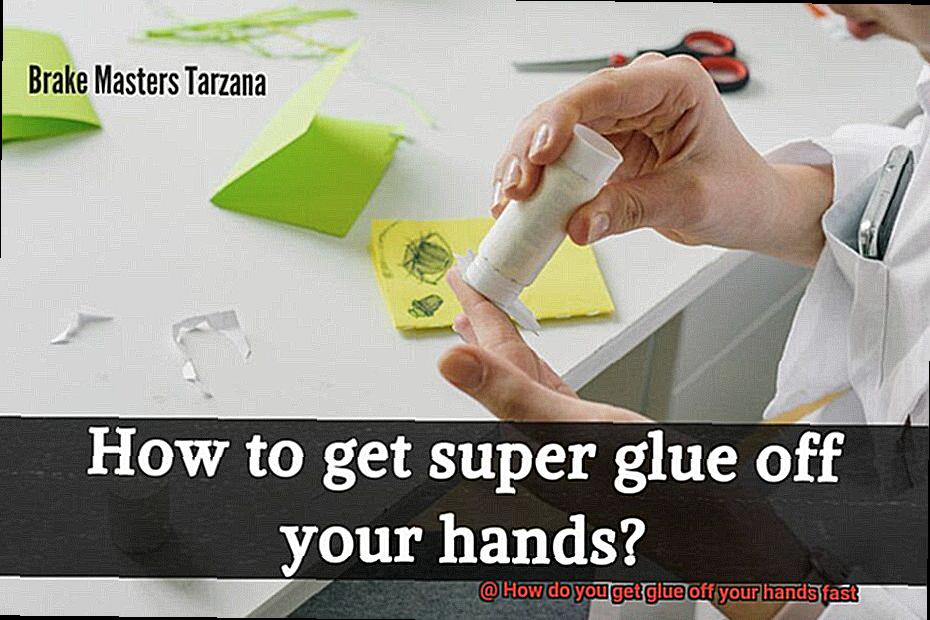Got glue on your hands?
No worries, I’ve got your back. We’ve all been there – sticky fingers, frustrating mess.
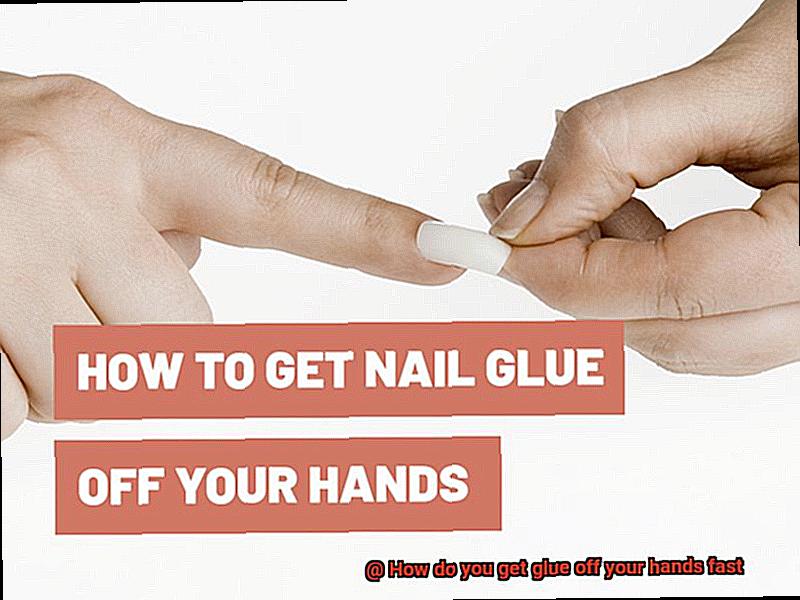
But fear not, my friend. I’m here to spill the beans on how to get that stubborn glue off your skin in a jiffy.
Say goodbye to gooey fingertips without breaking a sweat or resorting to harsh chemicals. From everyday household heroes to sneaky techniques, I’ve got the inside scoop on fast glue removal.
So, let’s dive into this magical world of secrets and bid adieu to those sticky situations once and for all.
What is Glue and Why Does it Stick?
Contents
- 1 What is Glue and Why Does it Stick?
- 2 Common Household Items for Removing Glue
- 3 Using Oil or Petroleum Jelly to Remove Glue
- 4 Utilizing Acetone or Nail Polish Remover
- 5 Natural Alternatives for Removing Glue
- 6 Abrasive Materials for Stubborn Glue
- 7 Preventative Measures to Avoid Getting Glue on Your Hands
- 8 Conclusion
Glue, that trusty adhesive that holds our world together, is a captivating substance with a history dating back centuries. It’s the unsung hero behind the seamless bond between two objects, whether it’s a delicate craft project or a vital repair job. But what exactly is glue, and how does it possess the magical ability to stick things together? In this article, we will delve into the world of glue, exploring its composition and unraveling the scientific secrets behind its remarkable stickiness.
What is Glue?
Glue is more than just a sticky substance; it is a carefully formulated adhesive designed to join objects together. Its composition typically includes an intricate blend of chemicals such as polymers, solvents, and additives. The specific combination of these ingredients varies depending on the intended use and the materials to be bonded. Some glues are tailor-made for specific surfaces like wood, metal, plastic, or fabric, while others are versatile enough to adhere to a multitude of materials.
How Does Glue Stick?
The secret to glue’s sticking power lies in its ability to create intermolecular forces between its own molecules and those present on the surfaces being bonded. These intermolecular forces can manifest as covalent bonds, hydrogen bonds, or van der Waals forces. When glue comes into contact with a surface, it spreads out and establishes contact with the molecules on that surface. The adhesive forces between the glue molecules and the surface molecules then work their magic, forming a bond that securely holds the objects together.
Factors Affecting Adhesive Strength:
To achieve optimal adhesive strength, several factors come into play. Surface cleanliness plays a crucial role; any dirt, oil, or contaminants must be meticulously removed to ensure proper adhesion. Temperature and humidity also wield influence over glue’s sticking abilities. Some glues require specific environmental conditions to cure properly and form a strong bond. Additionally, the amount of pressure applied during bonding can impact the adhesive strength, with greater pressure often resulting in stronger bonds.
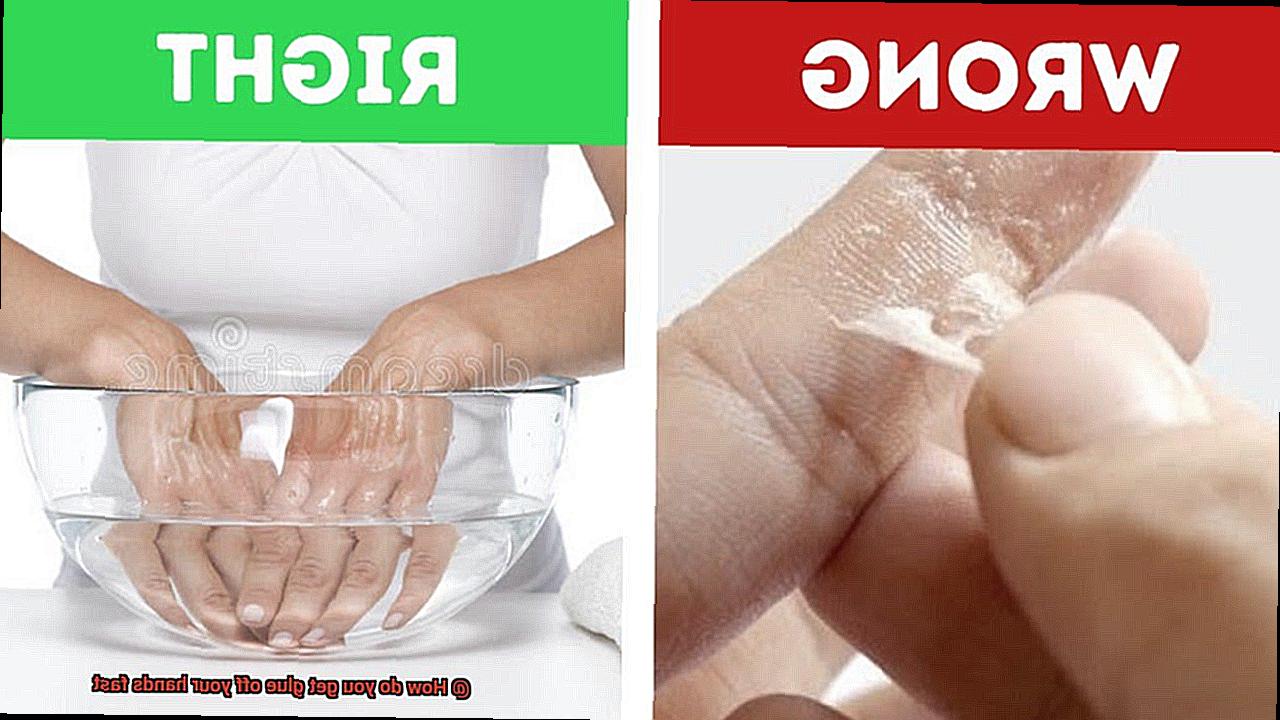
Different Types of Glue:
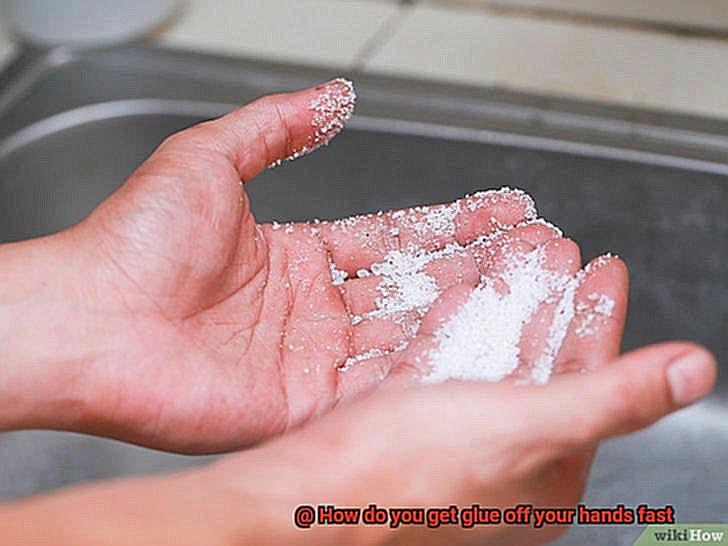
Glue manifests itself in various forms: liquid, gel, paste, or solid sticks. Each type offers unique advantages and is tailored to specific applications. Liquid glue, with its fluidity, is perfect for crafts and paper projects, effortlessly spreading and adhering to surfaces. Solid sticks, on the other hand, provide quick and easy bonding with their no-mess application. Gel and paste glues boast a thicker consistency, providing better control during adhesive application.
Common Household Items for Removing Glue
We’ve all experienced that frustrating moment when our hands become a sticky mess from glue. But fear not. With a few common household items, you can easily and effectively remove that stubborn glue. Let’s explore the world of household heroes and discover the best items for removing glue.
Soap and Water:
The simplest and most accessible solution is often the best. Break down the glue with soap and water, washing it away without any risks or adverse effects.
Cooking Oil:
If soap and water don’t do the trick, turn to your trusty kitchen staple – cooking oil. Apply a small amount to the affected area and gently rub it in. The oil helps loosen the glue, making it easier to remove. Remember to wash your hands with soap and water afterward to remove any residue.
Petroleum Jelly:
For particularly stubborn glue, petroleum jelly can work wonders. Apply a generous amount to the glue-covered area and let it sit for a few minutes. The jelly will soften the glue, allowing you to easily peel it off or wash it away.
Nail Polish Remover:
Nail polish remover containing acetone can effectively dissolve certain types of glue. However, be cautious as acetone can dry out the skin. After using nail polish remover, moisturize your hands to prevent dryness or irritation.
Hand Sanitizer:
When you’re on the go without access to soap and water, hand sanitizer containing alcohol can come to the rescue. Apply a small amount directly onto the glued area and gently rub until the glue starts to dissolve.
Vinegar:
For a natural adhesive remover, vinegar is your go-to solution. Soak a cloth or paper towel in vinegar and gently rub the glue-covered area until the adhesive starts to loosen.
Saltwater Solution:
Create a solution by mixing salt with warm water to tackle stubborn glue. Soak your hands in this solution for a few minutes, then gently scrub away the glue. Rinse with soap and water afterward.
Lemon Juice:
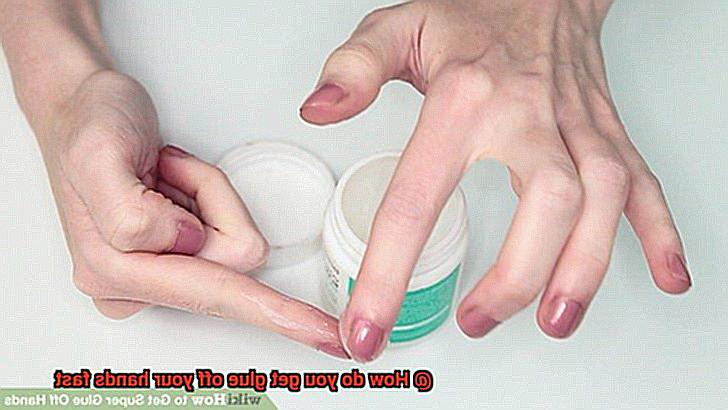
The citric acid in lemon juice can effectively break down certain types of adhesive. Apply lemon juice directly onto the glued area and let it sit for a few minutes before washing it off.
Remember, after using any of these household items, wash your hands with soap and water to remove any residue. It’s also important to test these methods on a small area of skin first, especially if you have sensitive skin or allergies.
Using Oil or Petroleum Jelly to Remove Glue
Imagine this: you’re in the midst of a creative frenzy, working on a craft project that’s sure to dazzle. But suddenly, your hands become ensnared in the sticky clutches of glue. Panic threatens to set in, but fear not. In this enlightening article, we’ll uncover the secret household heroes that can free your hands from this adhesive predicament. Today, we’ll focus on two mighty contenders: oil and petroleum jelly.
The Mighty Power of Oil:
When it comes to defeating the tenacious grip of glue, oil is an invaluable ally. But not just any oil will do the trick here. Opt for oils that are safe for skin contact, like gentle baby oil, nourishing olive oil, or versatile coconut oil.
Applying the Oil: A Skillful Dance:
To liberate your hands from the clutches of glue using oil, begin by applying a small amount onto the affected area. Gently massage it into the glue, allowing it to seep deep into its stronghold. Grant the oil a few minutes to weave its magic.
Wiping Away the Remnants: A Triumph Over Adversity:
Once the oil has worked its enchantment, seize a soft cloth or paper towel and gently wipe away the now softened glue. If necessary, repeat this process until every last vestige of glue has been vanquished.
Petroleum Jelly: A Viscous Savior:
Should you find yourself bereft of oil in your hour of need, despair not. Petroleum jelly, such as trusty Vaseline, can also come to your rescue. Apply a generous layer of petroleum jelly onto the glue and allow it a few moments to work its emollient wonders before proceeding.
Safety Precautions: Shielding Your Skin:
While these methods are generally safe for skin, it’s vital to consider individual allergies or sensitivities. To avoid any untoward reactions, always perform a patch test on a small area of skin before applying oil or petroleum jelly more extensively.
A Clean Slate: Bid Adieu to Residues:
Remember, once you’ve successfully liberated your hands from the clutches of glue, it is paramount to cleanse them thoroughly with soap and water. This ensures the removal of all traces of oil or petroleum jelly, leaving your hands pristine and residue-free.
Utilizing Acetone or Nail Polish Remover
We’ve all experienced the frustration of sticky hands after a craft project or DIY endeavor. Luckily, acetone and nail polish remover are our trusty allies in the battle against stubborn glue. This comprehensive guide will provide expert insights on how to effectively and safely utilize these products to remove glue from your hands.
Prepare the Environment:
Create a well-ventilated space by opening a window or turning on a fan to minimize exposure to strong fumes. Safeguard your work surface with a protective cloth or paper towel to prevent any accidental spills.
Assemble Your Tools:
Gather your arsenal, including acetone or nail polish remover, cotton balls or a soft cloth, and soap and water for hand washing afterward. Having everything within reach before you begin will streamline the process.
Application Technique:
Dampen a cotton ball or soft cloth with a small amount of acetone or nail polish remover. Gently dab the affected area, refraining from vigorous rubbing to prevent skin irritation. Start with a modest amount and gradually increase if necessary.
Allow Penetration Time:
Give the acetone or nail polish remover a few minutes to work its magic on the glue. This pause allows it to break down the adhesive properties of the glue, making it easier to remove.
Gentle Rubbing Action:
Using gentle circular motions, begin rubbing the glue off your hands. Exercise patience and avoid excessive scrubbing, as it can irritate your skin. Stubborn glue may require repeating this process multiple times.
Thorough Hand Washing:
After successfully removing the glue, cleanse your hands thoroughly with soap and water. This step eliminates any residue from the acetone or nail polish remover.
Moisturize for Replenishment:
Due to their drying nature, it is vital to moisturize your hands after using acetone or nail polish remover. Opt for a gentle, hydrating lotion or cream to restore moisture to your skin.
Important Tips:
- Perform a Patch Test: Before applying acetone or nail polish remover to your entire hand, conduct a small patch test on a tiny area of skin to check for adverse reactions.
- Avoid Open Wounds or Broken Skin: Refrain from using acetone or nail polish remover on cuts or abrasions. Seek alternative removal methods or consult a healthcare professional for guidance.
- Proper Storage: Keep acetone and nail polish remover out of reach of children and pets. Store them in a cool, dry place away from heat sources or flames.
Natural Alternatives for Removing Glue
Luckily, there are natural alternatives that can help you get rid of that stubborn adhesive without harsh chemicals or expensive products.
One popular method is using cooking oil. Just grab some vegetable or olive oil from your kitchen and apply it generously to the glue-covered area. Gently rub it in and let it sit for a few minutes. The oil helps break down the adhesive properties of the glue, making it easier to remove. Afterward, wash your hands with soap and water, and voila. Glue-free hands.
In case you don’t have any cooking oil on hand, vinegar can also do the trick. Soak a cloth or cotton ball in vinegar and dab it onto the glue. Let it sit for a few minutes, then gently rub the area until the glue starts to come off. Rinse with water and wash your hands with soap to remove any residual vinegar smell.
Another natural alternative is lemon juice. Squeeze some lemon juice onto a cloth or cotton ball and rub it onto the affected area. Thanks to the citric acid in lemon juice, the glue’s adhesive properties will be broken down. Allow it to sit for a few minutes before washing off with soap and water.
If none of these options are available, fear not. Mayonnaise can come to your rescue. Apply a thick layer of mayonnaise onto the glue and let it sit for about 10 minutes. The oils in mayonnaise help to loosen the glue, making it easier to remove. Wash your hands with soap and water afterward to eliminate any residue.
For those looking for an exfoliating approach, mix equal parts baking soda and water to create a paste. Apply this paste onto the glue and gently scrub in circular motions. The baking soda acts as an abrasive, helping to remove the glue while also exfoliating your skin. Rinse off the paste with water and wash your hands with soap.
Rubbing alcohol can also be used to remove glue from hands. Soak a cotton ball or cloth in rubbing alcohol and gently rub it onto the glue until it starts to dissolve. Rinse with water and wash your hands with soap afterward.
These natural alternatives offer effective and safe methods for removing glue from hands. They are easily accessible and do not require any harsh chemicals that may irritate the skin. Remember to always test a small area of your skin before using any of these methods to ensure that you do not have an adverse reaction.
Abrasive Materials for Stubborn Glue
We’ve all experienced the frustration of dealing with stubborn glue that just won’t budge. But fear not. With the right abrasive materials, you can easily remove glue residue from your hands. In this article, we will explore the best abrasive materials that will leave your hands glue-free and ready for action. Get ready to say goodbye to sticky situations.
Fine-Grit Sandpaper:
When it comes to removing stubborn glue, fine-grit sandpaper is a game-changer. Its gentle abrasive texture allows you to delicately rub away the glue residue without causing any harm to your skin. Remember, the key is to apply gentle pressure and avoid excessive rubbing to prevent irritation.
Pumice Stone:
If you’re looking for a natural solution, a pumice stone is your best friend. Wet the affected area and gently rub the pumice stone over the glue residue. The rough texture of the stone works its magic by loosening and lifting the glue off your skin. Just be careful not to go overboard and cause any skin damage.
Abrasive Sponge or Scrub Pad:
For a more convenient option, an abrasive sponge or scrub pad will do wonders. Wet the affected area and grab an abrasive sponge or scrub pad with a textured surface. With circular motions, gently scrub away until the glue residue is gone. To maximize effectiveness, pair it with a mild soap and water combination.
Moisturize and Soothe:
Once you’ve successfully removed the stubborn glue, it’s time to pamper your hands with some moisturizing love. Prevent dryness and irritation by applying a gentle moisturizer or natural oils like coconut oil or almond oil. And don’t forget to wash your hands thoroughly with mild soap and water to ensure there’s no sticky residue left behind.
Preventative Measures to Avoid Getting Glue on Your Hands
Glue can be a lifesaver when it comes to creating amazing projects, but let’s face it – it can also be a messy nightmare. There’s nothing quite as frustrating as getting glue on your hands and struggling to remove it. That’s why today we’re going to dive into some preventative measures you can take to avoid that sticky situation altogether.
First and foremost, prevention is key. It’s always better to stop glue from smearing your hands in the first place rather than dealing with the aftermath. Trust me, you’ll save yourself a world of time and frustration. So, what can you do to keep those hands glue-free?
- The power of gloves: Picture this – latex or nitrile gloves acting as your trusty shield against the sticky stuff. These materials are resistant to glue, so they’ll keep your hands clean and protected.
- Moisturize like a pro: Before embarking on any gluing adventure, slather on some hand cream or lotion. This creates a barrier that makes it harder for the glue to stick to your skin. Plus, it’ll make cleanup a breeze if any spills or splatters occur.
- Cover up: Imagine your work area covered in plastic sheeting, newspapers, or an old cloth, ready to catch any rogue drips or spills before they reach your precious hands.
- Be mindful: Slow down and take deliberate, calculated actions when handling glue. Mindful movements will help prevent accidental contact with your hands.
- Applicators are your best pals: Instead of diving in with your fingers, opt for applicators or brushes to apply the glue. This not only gives you more control over where it goes but also reduces the chances of it ending up on your hands.
- Keep it damp: Picture a damp cloth or paper towel at arm’s reach while working with glue. If you accidentally get some on your hands, swiftly wipe it off before it sets, sparing yourself a future battle with dried-on glue.
- Also Read: How do you remove dried Gorilla Glue?
Conclusion
In conclusion, removing glue from your hands quickly doesn’t have to be a sticky situation. With the right techniques and household items, you can easily bid farewell to stubborn glue and get back to your day without breaking a sweat.
Understanding the science behind glue and how it forms a strong adhesive bond is key. Glue creates powerful intermolecular forces with the surface it’s bonded to. Factors like cleanliness, temperature, humidity, and pressure can all impact the strength of this bond.
When it comes to getting rid of glue on your hands, there are numerous common household items that can come to your rescue. Simple yet effective solutions like soap and water work wonders in breaking down the adhesive. If you’re looking for alternatives, try using cooking oil, petroleum jelly, nail polish remover (with acetone), hand sanitizer (containing alcohol), vinegar, saltwater solution, or lemon juice – all handy options that can dissolve or loosen the glue.
For those who prefer natural remedies or have sensitive skin, cooking oil, vinegar, lemon juice, mayonnaise, baking soda paste, or rubbing alcohol can effectively remove any lingering glue residue.
But what about those stubborn glues that seem impossible to remove? Fear not. Abrasive materials such as fine-grit sandpaper, pumice stone, abrasive sponges or scrub pads can gently rub away even the most resistant residue.
To avoid getting glue on your hands altogether, consider using gloves as a protective shield and moisturize your hands before working with glue. Covering your work area with plastic sheeting or newspapers will catch any spills or drips. Using applicators instead of fingers for applying glue and keeping a damp cloth nearby for quick cleanup are also helpful preventative measures.
Always remember to test these methods on a small area of skin first and thoroughly wash your hands afterward.

